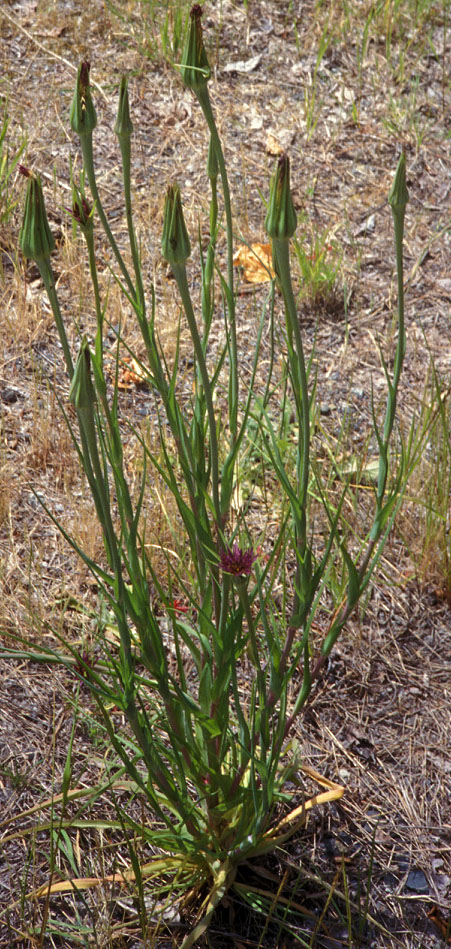
|

|
| Salsify; Tragopogon spp. |
Sunflower Family; COMPOSITÆ (ASTERACEÆ)
|
| Several salsify species exist. The purple-flowered species,
T. porrifolius, is cultivated as an edible root crop. The yellow-flowered species (T. dubius) grows wild exclusively. They are more easily spotted in June than in any other month. A thumbnail description
is: grassy leaves and giant dandelion-like seedheads. |
| From Europe, salsifies were early introductions to North America. They possess strength, resiliency, hardiness, and
other virtues. They also breed rapidly, like most weeds. Unlike their close cousin the dandelion, salsifies are neither perennial nor
shade-tolerant. No site can have too poor a soil, too dry, or too compacted for them. All salsify needs to get established is a place to
take root, with sufficient sunlight. |
| The seedlings usually sprout in fall or spring, grow for a year or so, then flower, whereupon they ripen seeds and die.
Hence the "biennial" designation as opposed to annual or perennial. From late April through October, some salsifies can be found
with flowers. The flowers open in the morning and "go to bed at noon." They are 1 to 21/2 inches wide, in composite clusters on
long stems. After fertilization occurs, the closed flowerheads swell-up into a weighty green affair that ultimately bursts forth into a
seedy puffball looking like that of a dandelion except closer in size to a tennis ball, and of a dirty brownish tinge. |
| The foliage is absolutely slender and reminiscent of pale grass, or young leek or garlic leaves. The very largest leaves
will measure 153/4 inches long, and at their clasping base
11/4 inches wide. If you snap a stem or leaf you'll find it bleeds a white sap
just like dandelion. Oxidization causes the sap to turn brown. The root, too, which is stout and carrotlike in shape, has white sap.
Salsify roots, leaves, flowerbuds and lowers are edible raw or cooked. The flavor is so mild as to be almost nonexistent. I figure it is
"basic chlorophyll with a trace of diluted sugar." Most people who eat salsify concentrate their efforts on the roots, and some swear the
flavor is like seafood. The purple-flowered species, grown as a root crop, is sometimes called Oyster Plant or Vegetable Oyster. I eat
the roots little, but the green parts much. It is one of the best lettuce-like wild plants available. |
| Medicinally, no especially potent salsify uses are known. Nonetheless, some herbalists use it. |
| If you want to find salsify wild, look for it in sunny meadows or roadsides or along railroad tracks. Remember, its
flowers close at noon. The Tilth weed patch has purple salsify. If you want to eat the starchy root, pluck it in late spring before it sends
energy into the leafy flowerstem. The flowerstems can grow to 5 feet high in gardens; the wild yellow species are smaller, only 1 to 3 feet tall. |
Another name for these plants is Goat's-beard, an English translation of
Tragopogon, in turn from Greek
tragos (goat), and pogon (a beard).
|
Originally published as the Seattle Tilth newsletter Weed of the Month in June 1994, along with an illustration from a book.
Back |
|
|

